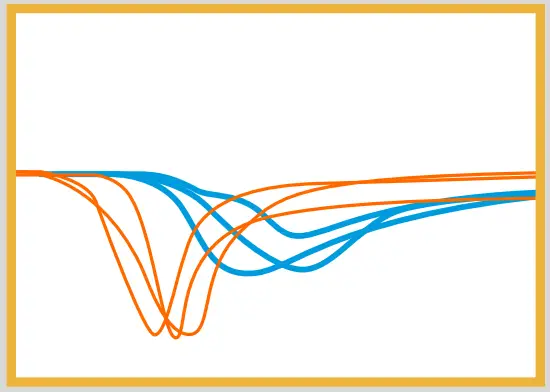Abbott Coronary Microvascular Dysfunction Algorithm

Catheter Engagement
(c)
- Flush thoroughly 1
- Coaxial guide engagement 1
- Ensure no damping1

(A)
Advance Wire
- Interrogate LAD unless there is a specific territory of interest 2
- Advance wire sensor 2/3 distally in vessel 3
- Administer GTN/NTG1

(T)
Transit Time at Rest
- Flush/purge pre-Tmn rest to clear any blood and contrast 3
- Room temperature saline 3
- Brisk 3 mL x 3 injections 3
- Address outliers (± 0.25s) before proceeding 4*
* Repeat measurement of Tmn rest

(H)
Hyperemic Transit Time
- Induce hyperemia 5
- Confirm hyperemia*6
- Flush/purge pre-Tmn hyp to clear any blood and contrast 6
- Room temperature saline 6
- Brisk 3 mL x 3 injections 6
- Address outliers (± 0.15s) before proceeding 4**
* Decrease in pressure, patient symptoms, FFR drop *
*Repeat measurement of Tmn hyp

(C)
Coronary Flow Reserve (CFR)
- CFR <2.5*4
- CFR grey zone 2.0-2.4*
* Evolving consensus

(M)
Index of Microcirculatory Resistance (IMR)
- IMR ≥252
- Use IMRcorr if FFR ≤0.807

(D)
Diagnosis
- Diagnosis of CMD based on IMR ≥25 and CFR <2.5*2,4
- CFR grey zone 2.0-2.4*
- Refer to guidelines and consensus document2,4, 8-9
* Evolving consensus

GTN (glyceryl trinitrate) |
NTG (nitroglycerin) |
LAD (left anterior descending) |
FFR (fractional flow reserve) |
IMRcorr (IMR corrected) |
CMD (coronary microvascular dysfunction) |
Tmnrest (resting transit mean time) |
Tmnhyp (hyperemic transit mean time)
References:
- Berry C. Fractional Flow Reserve, Coronary Flow Reserve and the Index of Microvascular Resistance in Clinical Practice. Radcliffe Cardiology. 2014, 1-6.
- Kunadian V, et al. EAPCI Expert Consensus Document on Ischaemia with Non-Obstructive Coronary Arteries. EHJ. 2020; 0, 1-21.
- Fearon W, et al. Invasive Assessment of the Coronary Microvasculature: The Index of Microcirculatory Resistance. Circ Cardiovasc Interv. 2017; 10:e005361
- Perera D, et al. Invasive coronary physiology in patients with angina and non-obstructive coronary artery disease. Heart. 2022; 0, 1-8.
- Ford T, et al. Stratified Medical Therapy Using Invasive Coronary Function Testing in Angina: The CorMicA Trial. JACC. 2018, 72, 2841-55.
- Ang D, et al. Interventional Diagnostic Procedure: a Practical Guide for the Assessment of Coronary Vascular Function. JOVE 2022; 181, e2265.
- Yong A, et al. Calculation of the Index of Microcirculatory Resistance Without Coronary Wedge Pressure Measurement in the Presence of Epicardial Stenosis. JACC: Cardiovasc Interv. 2013; 6, 53-8.
- Knuuti J, et al. ESC guidelines. EHJ. 2020; 41, 407-477.
- Gulati M, et al. 2021 Chest Pain Guideline, Circulation. 2021; 144, e368-e454.
Illustrations are artist’s representations only and should not be considered as engineering drawings or photographs.
Information contained herein for DISTRIBUTION outside of the U.S. ONLY. Check the regulatory status of the device in areas where CE marking is not the regulation in force.
Abbott International BVBA
Park Lane, Culliganlaan 2B, 1831 Diegem, Belgium, Tel: 32.2.714.14.11 www.cardiovascular.abbott ©2023 Abbott. All rights reserved. MAT-2114614 v3.0

Documents / Resources
 |
Abbott Coronary Microvascular Dysfunction Algorithm [pdf] User Guide Coronary Microvascular Dysfunction Algorithm, Microvascular Dysfunction Algorithm, Dysfunction Algorithm, Algorithm |
 |
Abbott Coronary Microvascular Dysfunction Algorithm [pdf] Instruction Manual Coronary Microvascular Dysfunction Algorithm, Microvascular Dysfunction Algorithm, Dysfunction Algorithm, Algorithm |



